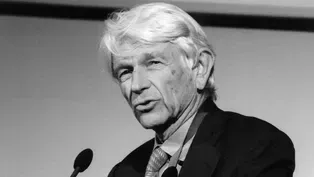
Animated History of Longevity
Clip: 5/1/2025 | 1m 44sVideo has Closed Captions
This animated sequence illustrates the dramatic increase in longevity throughout history.
This animated sequence illustrates the dramatic rise in longevity throughout history. From Ancient Times to the Middle Ages through the Industrial Revolution and up until the start of the 20th Century, life expectancy has steadily increased. However, the rise has been dramatic in recent years. There has been a greater gain in life expectancy in the last century than in the previous 5000 years.
Problems with Closed Captions? Closed Captioning Feedback
Problems with Closed Captions? Closed Captioning Feedback

Animated History of Longevity
Clip: 5/1/2025 | 1m 44sVideo has Closed Captions
This animated sequence illustrates the dramatic rise in longevity throughout history. From Ancient Times to the Middle Ages through the Industrial Revolution and up until the start of the 20th Century, life expectancy has steadily increased. However, the rise has been dramatic in recent years. There has been a greater gain in life expectancy in the last century than in the previous 5000 years.
Problems with Closed Captions? Closed Captioning Feedback
How to Watch Aging in America: Survive or Thrive
Aging in America: Survive or Thrive is available to stream on pbs.org and the free PBS App, available on iPhone, Apple TV, Android TV, Android smartphones, Amazon Fire TV, Amazon Fire Tablet, Roku, Samsung Smart TV, and Vizio.
Providing Support for PBS.org
Learn Moreabout PBS online sponsorshipMARTIN: For much of human history, life has been short.
Our early ancestors lived barely long enough to reproduce themselves.
The invention of tools and the development of agriculture increased the prospects for survival.
Yet 2,000 years ago, at the height of Imperial Rome, most Romans didn't live past age 25.
♪ Life continued to be brief and fragile through the Middle Ages.
♪ The Industrial Revolution that began at the middle of the 18th century increased wealth and longevity for a majority of people.
At the same time, a revolution in medical science, the germ theory of disease, new surgical practices and life-saving pharmaceuticals began to transform medical care.
Subsequent improvements in public health also lengthened life.
Still at the beginning of the 20th century, average life expectancy in the U.S. was just over 47 years.
Today, the average person in the United States can expect to live to the age of 77, a greater gain in life expectancy in the last 100 years than in the preceding 5,000 years.
While this new longevity is to be celebrated, the question remains, are America's institutions and social policies prepared for the rapidly increasing older population?
Video has Closed Captions
Clip: 5/1/2025 | 2m 58s | The current healthcare system was not designed to needs of a rapidly aging population. (2m 58s)
Video has Closed Captions
Clip: 5/1/2025 | 2m 40s | The gift of longevity is to be celebrated as many find new purpose in their later years. (2m 40s)
Video has Closed Captions
Preview: 5/1/2025 | 30s | Aging in America: Survive or Thrive is a one-hour documentary narrated by Martin Sheen. (30s)
Video has Closed Captions
Clip: 5/1/2025 | 2m 17s | Dr. Robert N. Butler was a pioneer and visionary who changed our perception of aging. (2m 17s)
Providing Support for PBS.org
Learn Moreabout PBS online sponsorshipSupport for PBS provided by:















